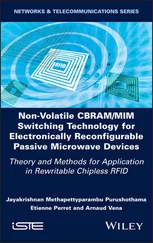Joel P. Dunsmore - Handbook of Microwave Component Measurements
Здесь есть возможность читать онлайн «Joel P. Dunsmore - Handbook of Microwave Component Measurements» — ознакомительный отрывок электронной книги совершенно бесплатно, а после прочтения отрывка купить полную версию. В некоторых случаях можно слушать аудио, скачать через торрент в формате fb2 и присутствует краткое содержание. Жанр: unrecognised, на английском языке. Описание произведения, (предисловие) а так же отзывы посетителей доступны на портале библиотеки ЛибКат.
- Название:Handbook of Microwave Component Measurements
- Автор:
- Жанр:
- Год:неизвестен
- ISBN:нет данных
- Рейтинг книги:5 / 5. Голосов: 1
-
Избранное:Добавить в избранное
- Отзывы:
-
Ваша оценка:
- 100
- 1
- 2
- 3
- 4
- 5
Handbook of Microwave Component Measurements: краткое содержание, описание и аннотация
Предлагаем к чтению аннотацию, описание, краткое содержание или предисловие (зависит от того, что написал сам автор книги «Handbook of Microwave Component Measurements»). Если вы не нашли необходимую информацию о книге — напишите в комментариях, мы постараемся отыскать её.
Handbook of Microwave Component Measurements — читать онлайн ознакомительный отрывок
Ниже представлен текст книги, разбитый по страницам. Система сохранения места последней прочитанной страницы, позволяет с удобством читать онлайн бесплатно книгу «Handbook of Microwave Component Measurements», без необходимости каждый раз заново искать на чём Вы остановились. Поставьте закладку, и сможете в любой момент перейти на страницу, на которой закончили чтение.
Интервал:
Закладка:
3 Collier, R.J. and Skinner, A.D. (2007). Microwave Measurements. London: Institution of Engineering and Technology. Print.
4 Collin, R. (1966). Foundations for Microwave Engineering. New York: McGraw‐Hill. Print.
5 Dunsmore, J. (1988). Utilize an ANA to model lumped circuit elements. Microwaves and RF: 11.
6 Freiberger, K., Enzinger, H., and Vogel, C. (2017). A noise power ratio measurement method for accurate estimation of the error vector magnitude. IEEE Transactions on Microwave Theory and Techniques 65 (5): 1632–1645.
7 Hong, J.‐S. and Lancaster, M.J. (2001). Microstrip Filters for RF/Microwave Applications. New York: Wiley. Print.
8 Hunter, I.C. (2001). Theory and Design of Microwave Filters. London: Institution of Electrical Engineers. Print.
9 IPC (2004). IPC‐2141A: Design Guide for High‐Speed Controlled Impedance Circuit Boards. Northbrook, IL: IPC Print.
10 Keysight Technologies. (1968). HP Application Note AN‐95‐1 [Online]. Available at: http://literature.cdn.keysight.com/litweb/pdf/5952-0918.pdf(Accessed 20 January 2020).
11 Kurokawa, K. (1965). Power waves and the scattering matrix. IEEE Transactions on Microwave Theory and Techniques 13 (2): 194–202.
12 Magnusson, P. (2001). Transmission Lines and Wave Propagation. Boca Raton, FL: CRC Press. Print.
13 Marks, R.B. and Williams, D.F. (1992). A general waveguide circuit theory. Journal of Research of the National Institute of Standards and Technology 97 (5): 535–562.
14 Mini‐Circuits. (n.d.) Amplifier Terms Defined AN‐60‐038 [Online]. Available at: http://www.minicircuits.com/app/AN60-038.pdf. (Accessed 11 Feb. 2012).
15 Pozar, D.M. (1990). Microwave Engineering. Reading, MA: Addison‐Wesley. Print.
16 Simons, R.N. (2001). Coplanar Waveguide Circuits Components and Systems. Wiley. Print.
17 Sombrin, Jacques, 2011. On the formal identity of EVM and NPR measurement methods: Conditions for identity of error vector magnitude and noise power ratio, Microwave Conference (EuMC), 2011 41st European, IEEE, 337–340.
18 Wen, C.P. (1969). Coplanar waveguide: a surface strip transmission line suitable for nonreciprocal gyromagnetic device applications. IEEE Transactions on Microwave Theory and Techniques 17 (12): 1087–1090.
19 Williams, D.F., Ndagijimana, F., Remley, K.A. et al. (2005). Scattering‐parameter models and representations for microwave mixers. IEEE Transactions on Microwave Theory and Techniques 53 (1): 314–321.
20 Zverev, A.I. (1967). Handbook of Filter Synthesis. New York: Wiley. Print.
Note
1 1Lord Kelvin, “On Measurement.”
2 VNA Measurement Systems
2.1 Introduction
S‐parameter measurements of devices provide the common reference for RF and microwave circuit and system analysis. While the basic methods of S‐parameter measurements were developed decades ago, many advances have occurred in just the last five years that makes obsolete the common understanding of the capabilities and limitations of these measurements. Vastly improved hardware and software capabilities provide for control of stimulus signals and analysis of response signals that allow measurement systems to extend the basic linear S‐parameters to multiport, differential, and non‐linear characteristics. In the past, S‐parameters were limited to two ports; now up to 32‐port systems are readily available. In the past, measurements were limited to linear responses; now non‐linear, distortion, noise, and even load pull characterizations are possible. In the past, calibration techniques were restricted to a few limited sets of standards and algorithms and limited to devices with the same input and output frequencies; now a wide range of calibration algorithms and applications can be applied to a variety of components, with few restrictions.
A clear understanding of the underlying architecture of a vector network analyzer (VNA) is necessary to understand the full capabilities and limitations of the modern VNA. The first part of this chapter deconstructs the VNA to discuss the individual block diagram elements, their attributes and deficiencies, and how they operate together to provide the capability and applications described in later chapters. In the history of VNAs, the HP 8753 and the HP 8510 were the industry‐leading RF and microwave VNAs of the 1980s and 1990s, from which many of the principal understandings of capabilities and limitations were formed. For that reason, many of the characteristics of these analyzers are discussed in the following sections to provide a context for the discussion of the modern VNA attributes. In almost all cases, many well‐known limitations of these products no longer apply, and a key goal of the first section of this chapter is to illuminate to the reader these improvements.
By around the year 2000, an arms race of sorts emerged in the world of VNAs with the nearly simultaneous introduction of the PNA and ENA families from Agilent, the Ballmann S100, the ZVR and ZVK from Rohde‐Schwartz, the Lightning™ and Scorpion™ from Anritsu, and the 3765 from Advantest. By 2010, Agilent and Rohde‐Schwartz advanced to the modern generation of multi‐function component test platforms, the PNA‐X and the ZVA, while Anristu's products remained mostly in the area of linear S‐parameter test in the form of the Vectorstar™. As the author is a principle designer and architect of the Keysight products, the details on the VNA architecture, structure, and capabilities described here are derived from this knowledge. But many of the factors discussed apply equally well to all measurement systems, regardless of manufacturer, including custom‐built systems sometimes seen in university research labs or national standards laboratories. Because of these advancements, many rules of thumb and common understandings based on the first generation of commercial VNAs are no longer relevant.
The second portion of this chapter describes the wide range of measurements and characteristics that can be derived from the basic measurements. In Section 2.3, the basic functionality for making measurements is described along with real‐world issues and errors that affect these measurements. Particularly in VNA‐based measurements, many of these errors can be characterized during a calibration process, and error correction can be applied to the results to remove, to a great extent, the effects of these errors. The calibration and error correction process will be described in detail in Chapter 3. Detailed descriptions of measurements of particular devices are covered in subsequent chapters: linear devices ( Chapter 5), amplifiers ( Chapter 6), mixers ( Chapter 7), and balanced devices ( Chapter 10).
Author's notes on the second edition: The evolution of VNA architecture has dramatically increased since the first edition was written in 2011. Almost all VNAs on the market today have a full reflectometer on each port, so the discussion the three‐receiver architecture presented in the first edition of this book (principally the architecture of the HP 8753) has been greatly reduced to make room for more interesting VNA enhancements such as true multiport.
2.2 VNA Block Diagrams
The basic block diagram for a component test system is a stimulus source, which is applied to the input of the device‐under‐test (DUT), and a response receiver at the output of the DUT. For S‐parameter measurements, the inputs consist of incident waves at all the ports, and the outputs consist of scattered waves at all the ports, so in general one would require a stimulus and two receivers at each port. In addition, there must be signal separation devices at each port to isolate the incident and scattered waves.
Early systems measured only transmission and/or reflection response, in only one direction, and thus consisted of at most a directional device (bridge or coupler) at the input and a receiver at the output. These systems were classified as transmission/reflection (TR) systems and were most commonly found as scalar network analyzers, although lower‐cost VNAs sometimes had TR test sets as well. The advantage of a vector TR analyzer is that the errors in the directional device could be removed with calibration and error correction.
Читать дальшеИнтервал:
Закладка:
Похожие книги на «Handbook of Microwave Component Measurements»
Представляем Вашему вниманию похожие книги на «Handbook of Microwave Component Measurements» списком для выбора. Мы отобрали схожую по названию и смыслу литературу в надежде предоставить читателям больше вариантов отыскать новые, интересные, ещё непрочитанные произведения.
Обсуждение, отзывы о книге «Handbook of Microwave Component Measurements» и просто собственные мнения читателей. Оставьте ваши комментарии, напишите, что Вы думаете о произведении, его смысле или главных героях. Укажите что конкретно понравилось, а что нет, и почему Вы так считаете.












